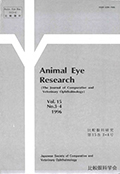Volume 15, Issue 3-4
Displaying 1-10 of 10 articles from this issue
- |<
- <
- 1
- >
- >|
President's Message
-
1996Volume 15Issue 3-4 Pages 3-4_89
Published: 1996
Released on J-STAGE: December 25, 2020
Download PDF (310K)
Tutorial Lecture at the 15th Annual Meeting of the Society
-
1996Volume 15Issue 3-4 Pages 3-4_91-3-4_96
Published: 1996
Released on J-STAGE: December 25, 2020
Download PDF (1709K)
Facility in the Field of Comparative Ophthalmology
-
1996Volume 15Issue 3-4 Pages 3-4_97-3-4_102
Published: 1996
Released on J-STAGE: December 25, 2020
Download PDF (1959K)
Original Reports
-
1996Volume 15Issue 3-4 Pages 3-4_103-3-4_113
Published: 1996
Released on J-STAGE: December 25, 2020
Download PDF (3399K) -
1996Volume 15Issue 3-4 Pages 3-4_115-3-4_122
Published: 1996
Released on J-STAGE: December 25, 2020
Download PDF (2429K)
Brief Note
-
1996Volume 15Issue 3-4 Pages 3-4_123-3-4_129
Published: 1996
Released on J-STAGE: December 25, 2020
Download PDF (2404K)
Reports at the 15th Annual Meeting of the Society
-
1996Volume 15Issue 3-4 Pages 3-4_131-3-4_136
Published: 1996
Released on J-STAGE: December 25, 2020
Download PDF (1795K) -
1996Volume 15Issue 3-4 Pages 3-4_137-3-4_146
Published: 1996
Released on J-STAGE: December 25, 2020
Download PDF (2976K) -
1996Volume 15Issue 3-4 Pages 3-4_147-3-4_154
Published: 1996
Released on J-STAGE: December 25, 2020
Download PDF (2412K)
Information and Data
-
1996Volume 15Issue 3-4 Pages 3-4_155-3-4_159
Published: 1996
Released on J-STAGE: December 25, 2020
Download PDF (1360K)
- |<
- <
- 1
- >
- >|
